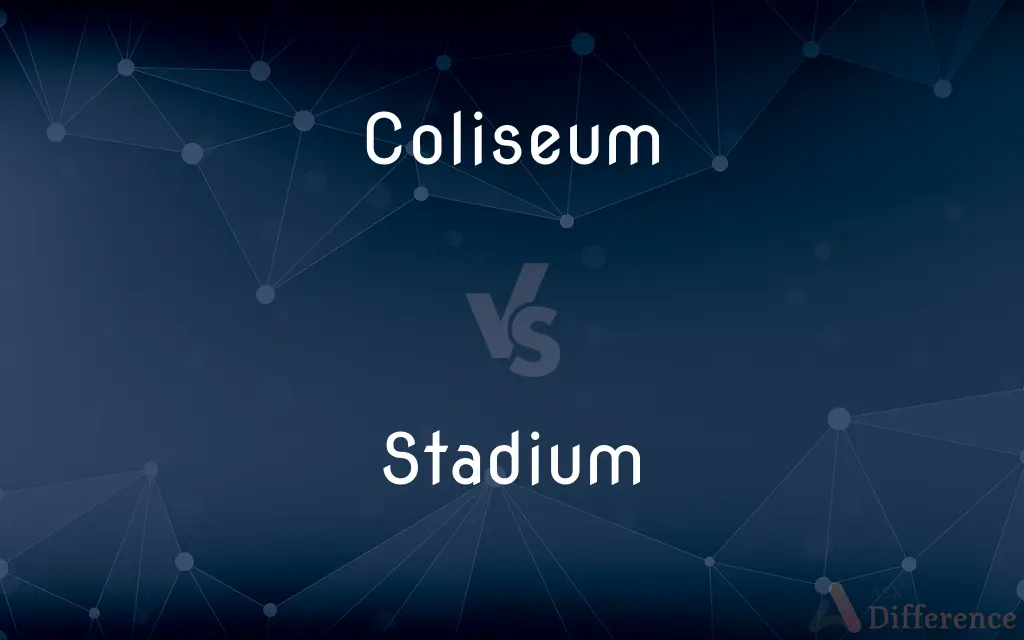Coliseum vs. Stadium — What's the Difference?
By Fiza Rafique & Maham Liaqat — Updated on March 11, 2024
The Coliseum often refers to a large amphitheater for events, particularly the Roman Coliseum, whereas stadiums are broader, modern sports arenas.

Difference Between Coliseum and Stadium
Table of Contents
ADVERTISEMENT
Key Differences
The Coliseum, historically linked to the iconic Roman Colosseum, was primarily designed for spectator sports, such as gladiatorial contests and public spectacles. Whereas stadiums, a more general term, encompass a wide range of modern sports and entertainment venues, designed to host a variety of events including football, baseball, and concerts.
The architectural style of the Coliseum, with its oval shape, tiered seating, and the use of arches, is a testament to ancient Roman engineering. On the other hand, contemporary stadiums often incorporate advanced materials and technology, featuring retractable roofs, digital screens, and versatile seating arrangements to accommodate diverse events.
Coliseums were central to social and cultural life in ancient Rome, serving as venues for public entertainment that reinforced social hierarchies and values. In contrast, modern stadiums are multifunctional spaces that not only host sports events but also serve as significant economic and social hubs within their communities, promoting a sense of unity and local pride.
The Coliseum in Rome had a specific design with the hypogeum, an elaborate underground structure used to house animals and slaves before their appearance in the arena. Meanwhile, modern stadiums prioritize facilities like VIP suites, concession stands, and state-of-the-art locker rooms to enhance the spectator and player experience.
Despite their differences, both the Coliseum and modern stadiums share the common purpose of bringing people together for shared experiences, highlighting the enduring human fascination with spectacle and communal events.
ADVERTISEMENT
Comparison Chart
Primary Use
Gladiatorial contests, public spectacles
Sports events, concerts, public gatherings
Architectural Style
Oval, tiered seating, extensive use of arches
Varied, often modern with retractable roofs
Historical Period
Ancient Rome
Modern era
Cultural Significance
Symbol of Roman might and social order
Centers for community engagement and entertainment
Technological Features
Hypogeum for staging events
Advanced amenities, digital screens, VIP areas
Compare with Definitions
Coliseum
Ancient Amphitheater.
The Roman Colosseum is an iconic example of an ancient coliseum.
Stadium
Modern Sports Arena.
The new stadium boasts state-of-the-art facilities for football and concerts.
Coliseum
Cultural Significance.
In ancient Rome, the Coliseum was a major venue for public spectacles.
Stadium
Economic Impact.
The construction of a new stadium can significantly boost the local economy.
Coliseum
Architectural Marvel.
The Coliseum's complex design and construction techniques are still admired today.
Stadium
Community Hub.
The stadium serves as a central gathering place for the local community.
Coliseum
Historical Monument.
The Coliseum remains a significant historical monument, attracting millions of tourists.
Stadium
Versatile Venue.
Stadiums today are designed to host a wide range of events, from sports to live music.
Coliseum
A large theatre, cinema, or stadium
The London Coliseum
Stadium
Technological Advancements.
The stadium's retractable roof and digital screens offer an enhanced spectator experience.
Coliseum
A large amphitheater for public sports events, entertainment, or assemblies.
Stadium
(surveying) a graduated rod used to measure the distance of the place where it stands from an instrument having a telescope, by observing the number of the graduations of the rod that are seen between certain parallel wires (stadia wires) in the field of view of the telescope.
Coliseum
A large theatre, cinema, or stadium.
The London Coliseum
Stadium
A stadium (plural stadiums or stadia) is a place or venue for (mostly) outdoor sports, concerts, or other events and consists of a field or stage either partly or completely surrounded by a tiered structure designed to allow spectators to stand or sit and view the event.Pausanias noted that for about half a century the only event at the ancient Greek Olympic festival was the race that comprised one length of the stadion at Olympia, where the word "stadium" originated.Most of the stadiums with a capacity of at least 10,000 are used for association football. Other popular stadium sports include gridiron football, baseball, cricket, the various codes of rugby, field lacrosse, bandy, and bullfighting.
Coliseum
A large, often circular building, for indoor sporting events, exhibitions, concerts, etc.; arena.
Stadium
A large, usually open structure for sports events with tiered seating for spectators.
Coliseum
The amphitheater of Vespasian at Rome, the largest in the world.
Stadium
A course on which foot races were held in ancient Greece, usually semicircular and having tiers of seats for spectators.
Coliseum
An oval large stadium with tiers of seats; an arena in which contests and spectacles are held
Stadium
An ancient Greek measure of distance, based on the length of such a course and equal to about 185 meters (607 feet).
Stadium
(Medicine) A stage or period in the course of a disease.
Stadium
(Biology) A stage in the development or life history of an organism.
Stadium
A venue where sporting events are held.
Stadium
An Ancient Greek racecourse, especially, the Olympic course for foot races.
Stadium
(historical) stadion, a Greek unit of length equivalent to about 185 m.
Stadium
A kind of telemeter for measuring the distance of an object of known dimensions, by observing the angle it subtends.
Stadium
(biology) A life stage of an organism.
Stadium
A Greek measure of length, being the chief one used for itinerary distances, also adopted by the Romans for nautical and astronomical measurements. It was equal to 600 Greek or 625 Roman feet, or 125 Roman paces, or to 606 feet 9 inches English. This was also called the Olympic stadium, as being the exact length of the foot-race course at Olympia.
Stadium
A race course; especially, the Olympic course for foot races.
Stadium
A modern structure, with its inclosure, resembling the ancient stadium{2}, used for athletic games which are typically played out-of-doors; such stadiums are usually large structures without roofs, though some modern stadiums may have a protective dome overhead. It may be contrasted with the arena, the term commonly used for smaller structures at which indoor games are played.
Stadium
A kind of telemeter for measuring the distance of an object of known dimensions, by observing the angle it subtends; especially (Surveying), a graduated rod used to measure the distance of the place where it stands from an instrument having a telescope, by observing the number of the graduations of the rod that are seen between certain parallel wires (stadia wires) in the field of view of the telescope; - also called stadia, and stadia rod.
Stadium
A large structure for open-air sports or entertainments
Common Curiosities
What events are held in modern stadiums?
Modern stadiums host a variety of events, including sports competitions, concerts, and public gatherings.
What is the Coliseum known for?
The Coliseum is most famous for hosting ancient Roman gladiatorial contests and public spectacles.
How does the architecture of the Coliseum differ from modern stadiums?
The Coliseum features an oval shape with tiered seating and arches, while modern stadiums often have versatile, technologically advanced designs.
What was the purpose of the Coliseum in ancient Rome?
The Coliseum served as a venue for entertainment that showcased Roman engineering and reinforced social order.
How do modern stadiums contribute to their communities?
Modern stadiums act as economic and social hubs, fostering community engagement and local pride.
What technological features are common in modern stadiums?
Features like retractable roofs, digital screens, and VIP suites are common in modern stadiums.
Can stadiums be considered cultural landmarks?
Yes, many stadiums are considered cultural landmarks due to their architectural significance and impact on community identity.
Are there still coliseums in use today?
While the original function of ancient coliseums has ceased, some serve as tourist attractions and historical sites.
What was the hypogeum used for in the Coliseum?
The hypogeum was an underground network used to stage animals and performers before their appearance in the arena.
How do coliseums and stadiums address spectator comfort?
Ancient coliseums had tiered seating for visibility, while modern stadiums focus on amenities like comfortable seating and concessions.
What is the economic impact of building a new stadium?
Building a new stadium can stimulate local economies by creating jobs, boosting tourism, and encouraging development.
How did the Coliseum impact Roman society?
The Coliseum played a central role in Roman society by providing a venue for entertainment that reflected social hierarchies.
What role do stadiums play in sports culture?
Stadiums are central to sports culture, providing a venue for fans to gather and support their teams.
Do modern stadiums have a historical significance like the Coliseum?
Some modern stadiums are significant for their architectural innovation or role in important historical events.
How were coliseums funded in ancient times?
Ancient coliseums were often funded by the state or wealthy individuals as a display of power and generosity.
Share Your Discovery

Previous Comparison
Idol vs. Idle
Next Comparison
Responsibility vs. IrresponsibleAuthor Spotlight
Written by
Fiza RafiqueFiza Rafique is a skilled content writer at AskDifference.com, where she meticulously refines and enhances written pieces. Drawing from her vast editorial expertise, Fiza ensures clarity, accuracy, and precision in every article. Passionate about language, she continually seeks to elevate the quality of content for readers worldwide.
Co-written by
Maham Liaqat













































